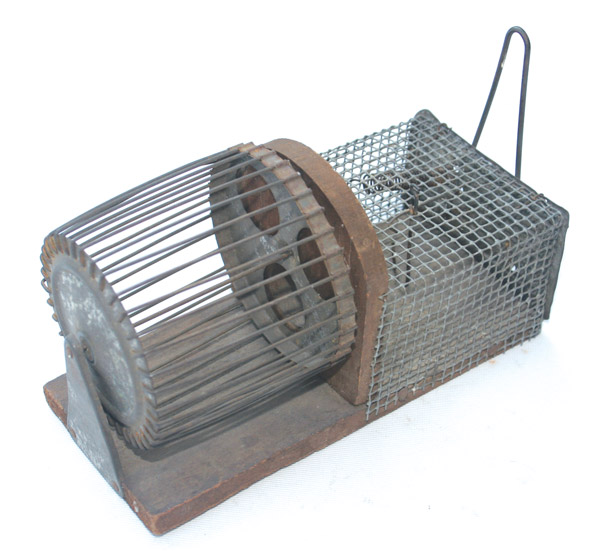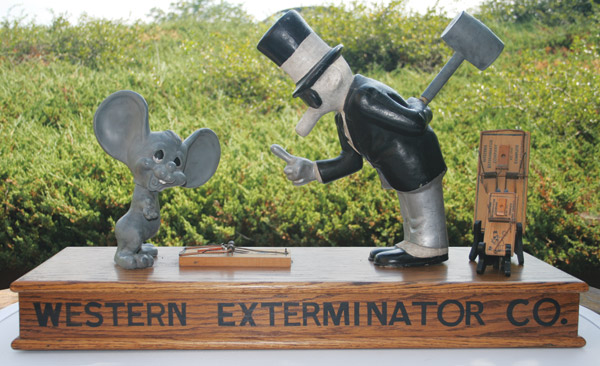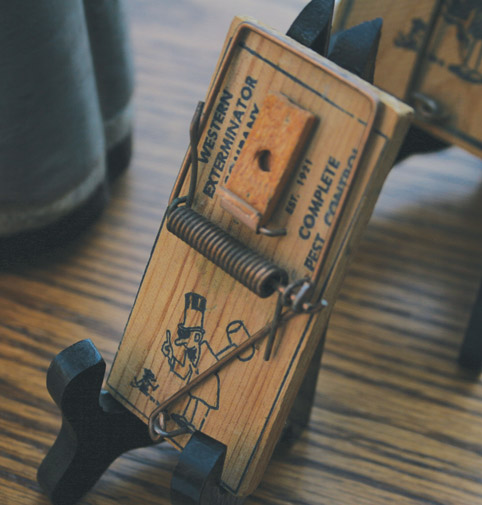 Antique Traps: A Better Mousetrap
Antique Traps: A Better Mousetrap 
By Tom Parr

“If a man can make a better mousetrap than his neighbor... the world will make a beaten path to his door,” wrote Ralph Waldo Emerson in 1871. Indeed, Emerson must have been taken seriously, because the variety of makes and models of such traps is almost endless. A Pennsylvania collection includes more than 4,000 distinct mousetraps and rattraps.
The first manufactured mousetraps in America came from England, brought by the first colonists. The Oxford English Dictionary suggests the term mousetrap first appeared in English usage during the last quarter of the 15th century. In 1590, Englishman Leonard Mascall compiled a volume titled: A book of Engines and Traps to take Polecats, Buzardes, Rattes and Mice.
The most common mousetrap in colonial America was likely a simple homemade deadfall that suspended a block of wood over a baited trigger. But by the mid 1800s, much more intricate mechanical devices were being built, perhaps more to satisfy the inquisitive mind than to control rodent populations.
One such trap was the Clown Face, a live-trap patented in 1878 by William Morris of Seward, Nebraska. The clown’s mouth opened, allowing a mouse to enter. Once in the trap, the mouse was guided into a separate holding compartment and the mouth reopened for another victim. Complete cast iron versions of this rare trap can bring as much as $2,000 on today’s collector market. Other early metal traps with names like Mousemobile, Catch-Em-Alive, Rapid Transit and Streeter-Anstice all command premium prices.
Toy wheel mouse traps were in vogue around the turn of the century. The Fairy, patented in 1909 by Frank Hamblin of Worchester, Massachusetts, is typical of the design. The mouse is caught in the first chamber, eventually finds the hole leading to the wheel, and then literally runs itself to death. Wheel traps sell today for from $75 to more than $300.
Choker-type traps with anywhere from one hole to six have been made of wood, plastic and metal. Most chokers go for $5 to $20 depending on the make and rarity. But a metal five-hole choker trap from Oneida Community is valued at about $100.
This inventive bend continued well into the 20th century. The plastic Kitty Got-Cha, made during the 1950s in Chicago, came in three colors and today sells for around $150.
But the largest variety of collectible mousetraps by far are the basic snap traps. Value for these is tied mainly to the markings on the wood bases. Traps like Out O’Sight, Knock Em Stiff, Joker, Gee Whiz, Devil, Terror and the like may fetch up to $100, as long as the printing is crisp and clear.
The beauty of collecting antique mousetraps is you don’t have to be a big spender to get started. Collectible snap traps may be found at many garage sales and flea markets for $5 or less.
* * *
For information on this and other collectible antique traps, contact: Tom Parr, the North American Trap Collectors Association, P.O. Box 94, Galloway, OH 43119; (614) 878-6011.


